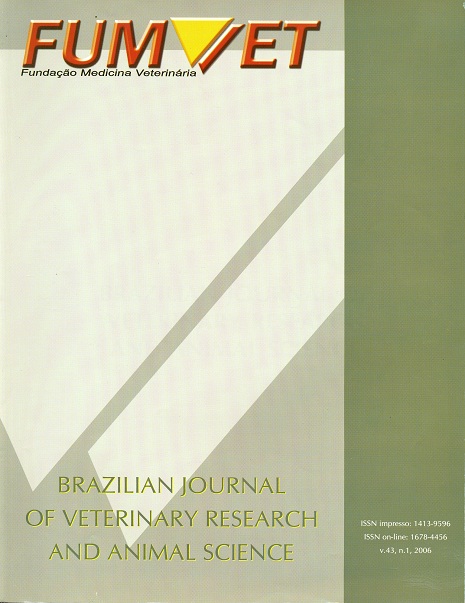Clinical variability in the determination of oral toxic dosis in the experimental intoxication with sodium fluoroacetate in cats
DOI:
https://doi.org/10.11606/issn.1678-4456.bjvras.2006.26526Keywords:
Sodium monofluoroacetate, Rodenticide, Intoxication, Clinical variability, Oral toxic dosisAbstract
The sodium monofluoroacetate (FAC) or compound 1080 is a potent rodenticide used for a rodents and vertebrate pest control. It was prohibited in many countries because of its high toxicity, but in Brazil exist evidences of ilegal use causing the intoxication in children and domestic animals. The fluoroacetate metabolite, fluorocitric acid, blocks body energy production by inhibit the Krebs cycle, resulting in neurological and cardiacs signs. In the present study, four group of oral toxic dosis of the FAC were compared in cats. The best oral toxic dose for clinical signs presentation, without cause acute lethality, was 0,45mg/kg. The clinical variability was dosis dependent and its intensity , in crescent order, was: light signs (dose 1: 0,3mg/kg), light to moderate (dose 2: 0,4mg/kg), moderate to severe (dose 3: 0,45mg/kg) and severe (dose 4: 0,5mg/kg). There was individual clinical variability between animals that received the same oral toxic dose.Downloads
Download data is not yet available.
Downloads
Published
2006-02-01
Issue
Section
UNDEFINIED
License
The journal content is authorized under the Creative Commons BY-NC-SA license (summary of the license: https://
How to Cite
1.
Collicchio-Zuanaze R de C, Sakate M, Crocci AJ. Clinical variability in the determination of oral toxic dosis in the experimental intoxication with sodium fluoroacetate in cats. Braz. J. Vet. Res. Anim. Sci. [Internet]. 2006 Feb. 1 [cited 2024 Apr. 26];43(1):117-24. Available from: https://www.revistas.usp.br/bjvras/article/view/26526





